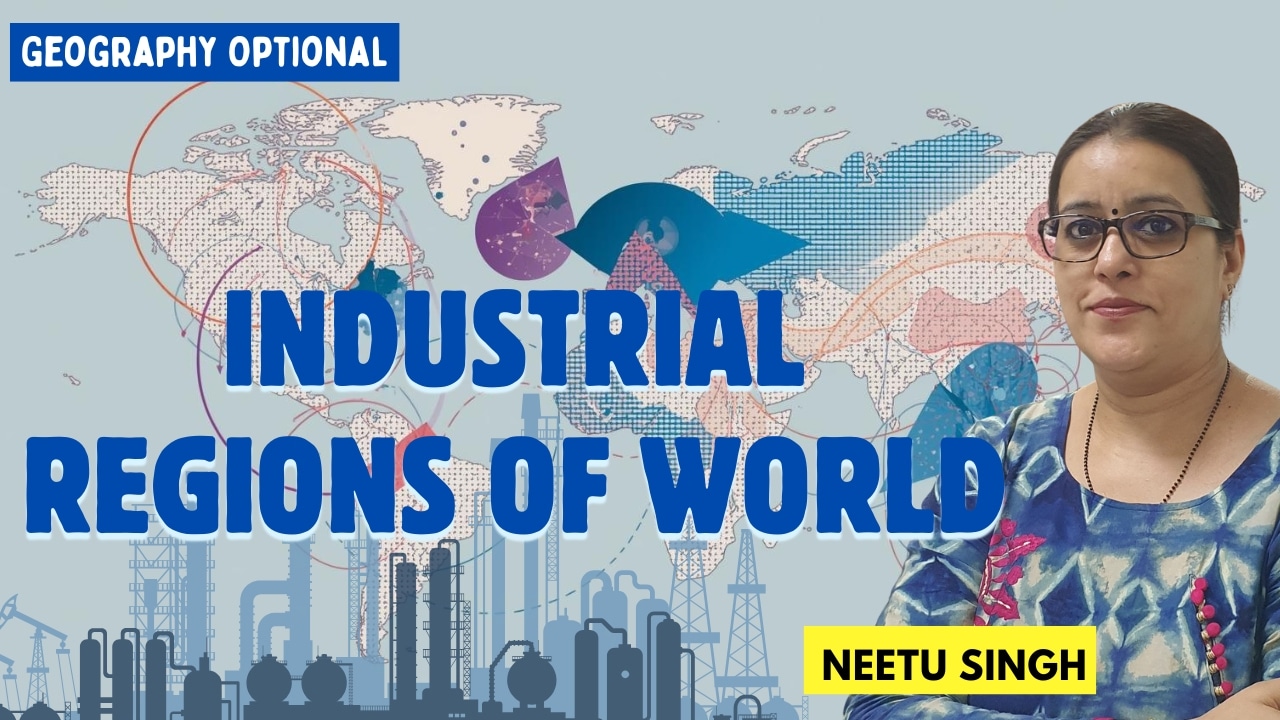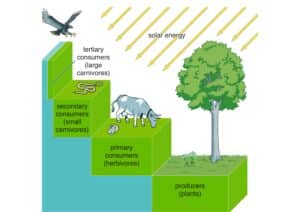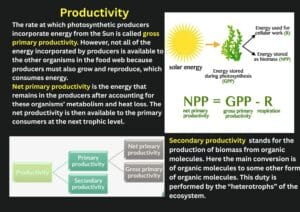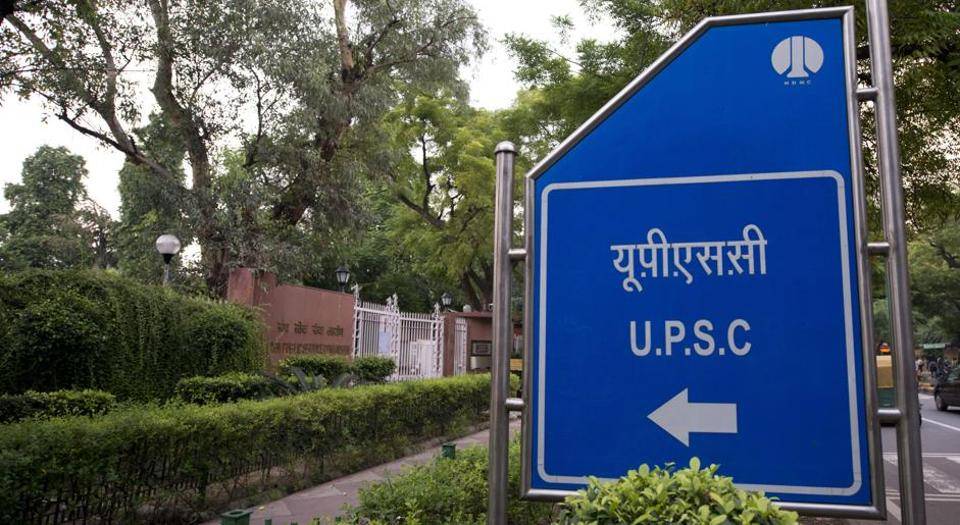MAJOR INDUSTRIAL REGIONS OF THE WORLD (विश्व के प्रमुख औद्योगिक क्षेत्र)
Industrial regions are those areas, where concentration of industries has occurred due to favorable geo-economic conditions. These are areas within which manufacturing industry is carried out on a relatively large scale and employs a relatively large proportion of population.
The spatial distribution of manufacturing units shows a distinct trend of localization towards a few selected areas; these regions are referred to as ‘industrial regions’.
The common characteristic features of the industrial regions are:
· Large population engaged in industrial pursuits,
· Large industrial complex in hierarchical order,
· Integration of some main industries with a group of subsidiary industries,
· Large banking and credit facilities,
· A network of communication lines, and
· A large market for labour supply, etc.
The industrial regions of the world are very unevenly distributed over the face of the earth. Both natural and cultural factors are involved in any explanation of the distribution of manufacturing regions of the world, but the great differentiations in localization of any industrial region can be explained to a large degree by the availability of resources.
Since the development of machinery, many industrial centers have sprung up where there is abundance of coal, or coal and iron, or extensive water-power – the mainsprings of modern industry, and all such towns are more or less business centers.
There are several factors affecting the concentration or localization of industry. The main localizing factors are: the market, the labor supply, the cost of land resources, the situation of raw material, the nature and situation of the natural and human resources, the value of the commodities produced in relation to the cost of the various items entering into their production, and finally, the supply of capital.
It is obvious that the profitableness of large scale operations must depend on the adequacy of the market, which is governed by various conditions as:
· The number of people where the industry is carried on.
· The purchasing power of the people, a great contrast in this respect being presented by developing countries as compared with developed countries and other semi-developed countries, in which the letter’s purchasing power is enhanced by the diffusion of education, and probably still more by the extent of the available undeveloped resources.
· The nature of the commodity for which a market is sought – cheap goods for peoples of small purchasing power, more valuable commodities for regions in which individual wealth is greater.
· Facilities for transport in enlarging the range of the market.
The spatial distribution of the industries shows a trend of concentration or agglomeration of industries in few regions where geo-economic conditions of industrial growth are favorable. These industrial regions have variety of industries and other infrastructures and are famous for their production of particular or varied types of industrial goods.
The major industrial regions of the world are as follows:
· North American region, comprising USA and Canada.
· European region, consisting of the industrial region of UK, Germany, France, etc.
· Industrial region of Russia
· Asian region, comprising the industrial regions of Japan, China, India, etc.
· Other isolated industrial regions.
NORTH AMERICA
• Manufacturing in North America is concentrated in the northeastern quadrant of the United States and in southeastern Canada.
• Only 5 percent of the land area of these countries.., contains one-third of the population and nearly two-thirds of the manufacturing output.
• This manufacturing belt has achieved its dominance through a combination of historical and environmental factors. North America Three Determining Location Factors:
• Population Proximity- Early settlement gave eastern cities an advantage to become the country’s dominant industrial center.
• Access to Raw Materials- had essential raw materials (by waterway or natural resources).
• Transportation- The Great Lakes and major rivers were a early determining factor is waterway transportation.
• Access to fresh water and power- proximity to great lakes
North American industrial region comprising of USA and Canada is a highly developed industrial region of the world. USA is now the wealthiest and most highly developed nation in the world. Southern Canada is also well developed.
The USA has become the world’s greatest industrial country. She had the immense advantages of space and virgin resources. The speed at which the industrial pattern of the USA is shifting and changing today is, in some sense, a measure of her industrial wealth and of the newness of her development.
The continent was peopled from the east. The oldest centers of industry lie along the eastern seaboard or in the valleys of the eastward flowing rivers. The industrial centers of the Middle West and of the Pacific coast are more recent.
The North American continent has many great industrial centers and a few industrial regions. This is partly the consequence of the widespread nature of the resources of the continent, and partly because of the late date at which industrialization took place.
The development of transport facilities and in recent years the generation and transmission of hydroelectric power have tended to cut industry adrift from the coalfields It is now having few areas of large scale concentration
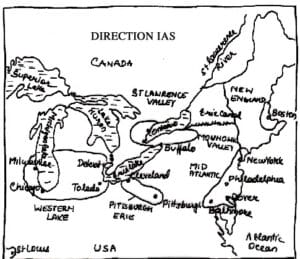
Southern New England:
This part of USA was the earliest to be developed by the settlers from England. Therefore, industrial growth also started earlier in this region. This is one of the oldest industrial regions in USA having a diversified industrial growth. The nucleus of the region is Boston with Connecticut; Massachusetts and Rhode Island are other major centers.
The two dominant industries which developed in this region are shipbuilding and textile, but both have now declined as newer centers with greater advantages have emerged in the Mid-Atlantic States, the Great Lakes and the West.
The engineering industry is still important, especially for the production of specialised goods, such as electrical machinery at Springfield, aircraft and armaments in Hartford, instrument-making at Bridgeport and textile-machinery manufacture at Worcester, Lowell and New Bedford.
Two towns, Boston and Beverly, are specialized in footwear machinery and the former is a shoemaking centre. The traditional textile towns are Lowell and Providence for woollen textiles; and New Bedford, Worcester and Fall River for cotton textiles; but these now produce mainly high-quality goods. Mass production is now more economic, farther south.
Mid-Atlantic States:
This region has a great diversity of manufactures. Inland, the variety of product, from the wrist watch to the giant locomotive; from the coarsest cotton to the finest silk; and from the deadliest and most powerful chemicals to perfumes are the outstanding characteristics of this industrial development.
Abundance of cheap and good anthracite coal of Pennsylvania, oil and natural gas from Appalachians have been important factors in encouraging development in the Mid-Atlantic Region. Coal is used in all units of this industrial region as a source of power but oil and gas are also important sources of energy. This is also the most densely populated part of the United States, a main source of skilled labor force, and this is also the main basis for the growth of enormous industrial conurbation from New York to Baltimore.
New York, situated on Manhattan Island, at the mouth of this important Hudson route from the interior via the Mohawk and Hudson valleys, is the largest city in the United States. It has an excellent harbour, and kilometers of wharves along the shores of the Manhattan Island and Long Island.
Leading industries were food and allied products; clothing and other textile products; printing and publishing; chemical and allied products; electrical equipment; transport equipment; and instruments. The town of Albany lies near the confluence of the Mohawk and the Hudson, and is noted for iron and steel manufactures.
Pittsburgh-Lake Erie Region:
This is the region having greatest concentration of ferrous industries. This region accounts about one-fourth of ferrous and ferro-alloy products of the country. The famous Youngstown-Pittsburgh-Johnstown iron and steel triangle is located in the region. The other steel-producing areas are Wheeling, Cleveland, Louisville, Rookford, Flint, Steubenville and Detroit.
The other manufacturing centres engaged in diversified manufacturing activities are Chicago, Anderson, Midland, Iowa, St. Louis, Minneapolis, etc. In cities like Detroit, several industries have developed including motor vehicles, machinery, fabricated metals, machine tools and electronics.
It also spreads down the Ohio River to Weirton, Steubenville, wheeling Huntington, Ashland, Ironton and Portsmouth and up the Miami valley to Middletown. Pittsburgh also has the largest glass industry in the United States. Most of the ore comes from Lake Superior. Cleveland, on Lake Erie, is noted for iron goods, electrical engineering and machineries.
Detroit Industrial Region:
This is the greatest automobile manufacturing region of the USA, centered at Detroit. The city was at first a centre for wagon and carriage-making which later led to the assembly of automobiles in the region.
It is the headquarters of several giant motor corporations including Ford, Chrysler, and General Motors. Other location advantages were the large market for cars in the Midwest, where other forms of transport, e.g., railways, were relatively poorly developed in the early 20th century; and the ease of transporting steel from Pittsburgh via Lake Erie.
The automobile industry extends to many other towns around Detroit, e.g., Lansing, Flint, Jackson, Pontiac, Dearborn and Toledo; and car assembly is linked with other branches of manufacture such as tyre-making, electrical wires, glass, batteries, paints, polishes, alloyed steel, spare parts and components.
Lake Michigan Region:
This area lies on the southern shores of Lake Michigan with Chicago as a main centre. There are some 10,000 factories in and around Chicago, amongst which the iron and steel plants are the most important.
The manufacturing industries around Lake Michigan are confined largely to Chicago and Gary where iron ore of the Lake Superior and of north meets coal from the south. Chicago, near the head of Lake Michigan, is now the second largest city in the United States.
Its chief advantage lies in the fact that railways from the north-west are obliged to pass through it in rounding Lake Michigan to reach the Atlantic, while it also forms a good centre for railways from the south. Chicago concentrates on motor vehicles and trucks, cement, chemicals, iron and steel goods, furniture, paper, cereal, baby food and pharmaceuticals.
Other industries are based on the agricultural products of the surrounding regions, e.g., meat-packing, grain milling and the making of agricultural implements and machinery. Gary near Chicago is important for iron and steel production.
Closely associated with the Chicago metropolitan area are such urban centres as Milwankee, Racine and Kenosha with their extensive iron and steel, motor vehicle, beverage, machinery, meat packing, leather and leather goods establishments. Chicago, Gary and Milwankee depend upon it now for the delivery of Upper Lake ore.
Southern Appalachian Region:
This is a very distinctive steel making area centred at Birmingham in the piedmont of the southern Appalachians in the state of Albania. The availability of coal and iron, later supplemented by oil and hydroelectric power from the Fall line are responsible for the growth of this industrial area. Other industrial cities of this region are Atlanta, Gadsden, Bessemer, Anniston and many others.
Cotton textiles and chemicals are now manufactured in several industrial towns of this industrial region where water power is available. It makes a very wide range of goods such as metal works, chemicals and machinery manufacture.
Eastern Texas:
The industrial development of this region is based on oil, as a source of fuel and as a raw material. The main centres of this region are cities of Dallas and Houston. This region is also rich in sulphur, rock salt and phosphate rock. This makes oil refining and chemical industries the most important in the region. Their situations on the coast have additional advantage of transportation.
The capital available by the oil industry helps in industrial development. Dallas has more than twelve oil refineries, chemical plants, synthetic rubber factory as well as steel milling and manufacture of mining equipment and consumer products. Dallas also has clothing and fashion industry and Fort Worth is famous for aircraft and aerospace industries.
Pacific Coastal Region:
This region is a narrow coastal strip running through Washington, Oregon and California. This is one of the great industrial agglomerations of the Pacific coast. Its industrial centers are San Francisco and Los Angeles.
This region is famous for food and beverages, automobiles, aircraft, metal fabrication, petrochemical and heavy chemical industries. The other industrial centres of this region are Portland, Seattle, Engine, Sacramento, San Diego, etc.
Apart from the above mentioned industrial regions, there are some large isolated industrial centres in USA which are known for their industrial products. St. Louis has meat-packing, flour-milling, footwear, and agricultural machinery industries. Kansas City has similar manufacture of products plus aircraft and oil refining.
Others like Omaha, Cincinnati, Indianapolis, Denver, St. Paul and Minneapolis, and Memphis concern themselves mainly with agricultural industries, being located in the midst of America’s richest agricultural region. Flour-milling, meat-packing, cotton textiles and food processing are some of the major industrial undertakings.
Bordering the Gulf of Mexico are several towns that serve as the outlets of the Mississippi basin and have industries linked with the oil found in the region. New Orleans has oil refining, chemicals and cotton textile industries.
Major Industrial Regions of Canada
In North America, Canada is the second largest industrial region. The country is rich in mineral resources like iron ore, petroleum and forest resources and also has abundant hydroelectric power.
Ontario and St. Lawrence Valley:
This is one of the most important manufacturing regions in Canada. The major products are paper, cheese, flour, agricultural machinery, copper and nickel smelting, iron and steel industry and chemical industry. The major industrial centres are Quebec, Ontario, Ottawa, Toronto, Hamilton, etc.
Prairie Region:
As far as manufacturing industry is concerned, this region is not very developed. The major centres of production are Manitoba, Winnipeg, Edmonton, Alberta, etc. Besides agro-based industries, the other noted industries in the region are petroleum refinery and chemical industry.
Pacific Coastal Region:
In this region industry like paper and pulp, furniture, agricultural machinery, etc., have been developed. The major industrial centres of this region are Vancouver and Prince Rupert.
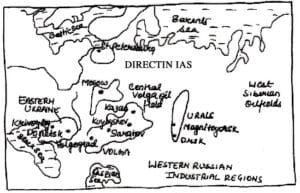
• Access to Raw Materials- the Asia Pacific region is one of the major growing regions of natural fabrics such as cotton. Also has large coal and iron deposits
• Transportation- Near the oceans and waterways for transport
• Labour Supply- the Asian countries are some of the most densely populated areas of the planet meaning there are a lot of labourers available that also work for low wages
In Asia, China, Japan and India have done considerable progress in industrial development. Hong Kong, Korea and Taiwan have become major exporters of textile and other goods.
The South-East Asian Region, though traditionally agricultural in outlook, is also developing industries. Singapore is the most industrialized of the South-East Asian countries. Oil is the major resource of Middle East; therefore, oil refining and petrochemical industry have become important in the region. Iran has developed a wide range of industries.
Chinese industrial regions
Industrial development in China began only after the beginning of Communist rule in 1949, and now China is not only art industrial power of Asia but also of the world. There has been a complete transformation of the industrial system during the last 60 years.
Under the new system and policy, China is developing its industrial system in a planned manner. Rapid development has made China a leading producer of iron and steel, textiles, and cheap consumer goods such as toys, household goods and light metal goods. In China, following industrial regions have been identified:
Manchurian Region:
The most important industrial area of China is in Manchuria with centres at Anshan (steel industry), Penki (steel industry), Fushun (coal, lubricating oil, and chemicals), Mukden or Shenyang (machinery and tools) and Dairen (mills and shipyards) – all of them near coal and iron ore deposits. Anshan, Fushun and Shenyang form a triangle, within which are numerous large plants.
Here, China developed the largest coal mine, by far the largest blast furnaces and almost the only important steel mills, major factories for railway equipment, cement plants, chemical works, military arsenals and factories for the processing of agricultural products. This was principally an area of heavy industry.
Tientsin and Beijing Region:
A second industrial area has been developed at the northern end of the North China Plain, near the Kailan coal reserves, with Tientsin, Peking or Beijing and Tangshan as its main centres.
This industrial complex centred on Tientsin and extending from Chinwang to southward along the coast past Kaiping, Tangshan and Tangshu, and thence westward beyond Beijing. The presence of coal-fields in Shansi and Hopei has contributed to the rise of the metallurgical and engineering industries here.
Beijing, Tientsin and Tangshan produce coal, steel and machinery making this northern region the industrial centre for the whole of the North China Plain. The industrial economy of the area has much in common with that of Manchuria.
Lower Yangtze Industrial Region:
This is China’s oldest industrial region because the area has been open to foreign influence since the middle of 19th century. Shanghai is the main industrial town and port of this industrial region. This is an area for the production of consumer goods such as cotton, silk, textile, food, leather, radio, television sets, utensils, leather, etc. Shanghai’s population has now increased rapidly.
The needs of the city and its productive hinterland led to factories being set up, partly supplied from overseas; these produced foodstuffs and included flour and oil mills. Paper and tobacco factories were also established, and later the first machine repair shops, from which the present-day iron steel and machines industry has developed.
The cotton textile mills of Shanghai industrial region are some of the largest in Asia. Shanghai and the lower Yangtze Delta area clearly lead in total industrial output. There are also shipyards, oil refineries, flour mills, steel plants, metal works and a great variety of light industrial products.
The Middle Yangtze Industrial Region:
The industrial centre furthest inland was the one on the middle Yangtze plain around the former tripartile town of Hankow-Hanyang-Wuhan, with the river navigable for large ocean going vessels up to that point. The iron and steel works here are based on Peninsiang coal and Tayeh iron ore. Shipbuilding, metallurgical and heavy industries, railway equipment and chemicals are important items of production.
Yangtze forms a magnificent waterway, being navigable for large ocean vessels nearly 1,600 km from its mouth. The next important town is Hanyang. Hanyang lies not far from coal and iron ore deposits and was in fact the cradle of China’s heavy industry. Engineering and textile works were later set up, together with foodstuffs factories.
Sichuan (Szechwan) Industrial Region: Sichuan (Szechwan) province above the Chang Jian (Yangtze Kiang) gorge has many important industries around Chongqing (Chungking) and Chengdu (Chengtu).
The rich deposits of coal, iron, ferro-alloys and abundant agricultural raw materials have all encouraged industrial development. Iron and steel, textiles, paper and pulp, machinery, cement, and chemicals are made here.
Si Kiang Delta Region:
At the mouth of the Xi Jiang (Si Kiang) the port of Canton is the main industrial centre. Canton lacks local raw materials and once was known largely for commerce. Modern industries are centred on silk production; there are silk mills, jute and cotton goods are manufactured, rubber is processed, and there are food-canning and match factories. Iron works and machine factories occupy sites near the docks.
The iron ore comes from Hainan Island. There are also mechanised porcelain factories. But, in spite of Cantons many industries; it is firstly a trading centre for the exchange of goods between the interior and countries overseas.
Food processing factories have recently been established at Swatow. Next along the coast come the towns adjacent to Canton-Fatshan which produces textiles and household goods, Shuntak (for silk and sugar), Tungkuan (sugar and food) industries.
Japanese industrial regions
Japan is the highly industrialized country of Asia. Despite its shortage in industrial raw materials and solid fuel, it has been able to develop industries at a very fast rate.
The reasons of rapid industrial growth in Japan are:
· Availability of hydroelectric power.
· Coastal location and large ports which helps in import of raw material and also in export.
· Proximity to mainland of Asia providing a ready market. Now, Japan has a worldwide market for its products.
· Country’s large population provides a ready source of labour.
· Technological development.
· Government encouragement, etc.
Tokyo-Yokohama Region:
The greatest industrial region of Japan is the Kwanto plain and is formed by the conurbation of three chief cities, Tokyo, Kawasaki and Yokohama. Tokyo the capital of the country, is favourably situated in the middle of a small fertile plain known as Kwanto plain, and carries on many artistic industries.
Tokyo is noted for electrical engineering such as transistors, radio television sets, washing machines, refrigerators and computers. Today, it ranks high in blast furnaces, steel mills, machines and tools, chemicals, refineries, shipbuilding, airplane, factories of consumer goods, electrical machinery, textile and canning indus¬tries, etc.
Yokohama is a port city where manufacturing has been overshadowed by trade. One reason for the slower development of industry has been restricted area of level land suitable for the expansion of factory sites. Yokohama has precision engineering, shipbuilding, oil refining, petrochemicals and port industries.
The third industrial city is Kawasaki. Its Heavy Industries Ltd., Japan’s top manufacturer of industrial robots, is planning to bolster production and step up sales, including those in Europe and the USA to meet the growing demand.
Though about 90 per cent of robots it makes at present are arc welders for sale to car manufacturers. It will be placing heavier emphasis from now on to the output of robots for other purposes, such as spray painting and assembling.
Osaka, Kobe and Kyoto Region:
In the Hanshin or Kinki region are three of the Japan’s six great cities – Osaka, Kobe and Kyoto, the first two of which are also among the three great deepwater ports. The manufacturing structure of the Hanshin region is one of great diversity.
Until recently at least, textiles lead all other industries. The cotton industry is carried on chiefly at Osaka and other towns in the fertile plain that borders the northern shore of the inland sea.
Osaka is the greatest cotton-textile town and is generally known as the Manchester of Japan. Here the naturally dense population makes labour cheap, and affords a good market. As Osaka has just one poor harbour, it is largely served by the port of Kobe.
The Osaka-Kobe industrial region is as smoky, noisy and unattractive in appearance as are most regions of heavy industry. Kobe concentrates on shipbuilding, oil refining, and petrochemical industries including synthetic textile and rubber manufacture.
The Nagoya Industrial Region:
The third industrial region of Japan is Nagoya. Nagoya has textile mills that process local silk, imported cotton and also synthetic fibres; engineering indus¬tries, including all kinds of machinery automobiles, locomotives and aircraft.
Textile, including silk reeling, cotton spinning, cotton weaving and wool weaving lead all other industries. Much of Nagoya’s woollen industry is relatively new and Australian wool is chiefly used. Nagoya is one of the country’s foremost aircraft manufacturing centres.
Northern Kyushu Region:
This industrial region is located close to the south-western limit of the general manufacturing belt in northern Kyushu. It ranks 4th among the manufacturing concentrations, being credited with nearly 90 per cent of the nation’s industrial output.
Chikuho coalfield is situated in close proximity of this heavy industrial centre. Textiles are not an important element of the industrial structure of this region; of first importance are the heavy industries, especially iron and steel manufacturing.
Yumata, Kokura, Moji, Fukuoka are the industrial centre of this region. Outside the above four major industrial regions there are several scattered industrial towns. Iron and steel is made at Muroran; oil refining is important at Akita and Niligata; engineering at Hiroshima; shipbuilding at Kure; textiles at Okayama. Hakodate and Sapporo in Hokkaido also have some industrial development.
Important Industrial Regions of Europe
Manufacturing Centers in Western Europe
The major manufacturing centers in Western Europe extend in a north-south band from Britain to Italy. Rhine—Ruhr Valley –Transportation- This location at the mouth of Europe’s most important river has made Rotterdam the world’s largest port. –Proximity to Raw Materials- Iron and steel manufacturing has concentrated in the Rhine—Ruhr Valley because of proximity to large coalfields. This has resulted in major automotive and machinery manufacturing plants. –Labour Supply- proximity to large cities provides lots of available labourers
Industrial revolution was first started in Europe, with the result heavy industries on a large scale have developed in many parts of the Europe.
In spite of industrial development in many regions of the world, Europe is still a great industrial power. In Europe, industries are distributed in many countries and the manufacturing belt of Europe is not continuous.
The principal manufacturing zone extends from west to east, from Britain through north-eastern France, Belgium, the Rhineland of West, Germany, and Saxony-Bohemia to Silesia. Other important industrial areas are found on the Swiss Plateau, northern Italy, in central Sweden and in many large towns and cities throughout Europe such as London, Paris, Berlin and Milan
The place of Europe‘s primary industrial regions still reflects the spatial diffusion of the Industrial Revolution. An axis of manufacturing extends from Britain to Poland and the Czech Republic, and onward to Ukraine. The explanation of this pattern lies in the place of coal fields in Britain and the European continent. Britain‘s coal fired industries produced a pattern of functional specialization that, for a time, had no equal in the world, for it was coal that fired the Industrial Revolution. Europe‘s coal deposits lie in a belt across northern France, Belgium, north-central Germany, the northwestern Czech Republic, and southern Poland—and when the Industrial Revolution diffused from Britain onto the mainland it was along this zone that Europe‘s major concentrations of heavy industry developed. Europe‘s industrial success also depended on the skills of its labor force and the high degree of specialization achieved in various industrial zones.
United Kingdom:
UK was the first country in the world to become highly industrialized. Most of its industrial regions are closely associated with the coalfields. At the present time industry is declining due to cheaper and more efficient production overseas, and with old equipment and labour troubles at home. But still the industrial structure of UK is considered important
The North-East Coast:
The north-east coast industrial region also accords fairly closely with a coalfield, that of Durham and Northumberland. Again the basic industries are coal mining and iron and steel production. Its economic fortunes have not differed greatly from those of West Cumberland in recent years, though a greater variety of steel processing industries and also other industries, such as chemicals, have been established.
Foremost amongst these is the shipbuilding industry of the Tyne. Marine, mechanical and constructional engineering are also relatively important. The chemical industries have recently assumed great importance at Birmingham.
Cumberland and Westmorland:
This region occupies very approximately the coalfield that lies between the Lake District hills and the sea. It is a less specialized region. Apart from coal mining, now of declining importance, iron and steel production is the principal industry.
The West Riding of Yorkshire:
This district is dominated by the manufacture of woolen and worsted cloth. Second in importance comes coal mining and iron and steel production. In general, the former occupies the more northerly valleys, centered on Leeds, and the latter, the more southerly, with their focus in Sheffield.
The West Riding, unlike the two regions already mentioned, has attracted a large number of subsidiary industries — those which absorb the by-products or work up the main products of the principal industries and those which serve the needs of the large industrial population.
Nottinghamshire and Derbyshire:
These counties contain the southern extension of the West Riding coalfield. Here the woollen industry gives way to hosiery, which has, in large measure, replaced the ancient lace industry. Coal mining remains important and many branches of the engineering industry are carried on.
Railway and motor engineering, the manufacture of cables, rayon, heavy chemicals and pharmaceutical goods are amongst the products of this area which must count as one of the most varied industrial regions of the country.
The Birmingham Region (Midlands):
The Birmingham region is now much more extensive than the coalfields of South Staffordshire and Warwickshire from which it grew. It is impossible to point to any predominant industry, though the manufacture of motor cars is one of the most important.
Greater London:
This region has the greatest variety of industry to be found in any industrial region in Great Britain. None is basic or fundamental to the area in the sense that it could not be carried on equally well elsewhere. Most are concerned with the manufacture of consumer goods; furniture, ready-made clothing, musical instruments, patent and prepared foods.
South Wales:
A region of coal and steel, South Wales has been in recent years as depressed as similar areas in the north of England.
Scotland:
Central Scotland contains a number of coalfields and on these local resources a number of varied textile, metallurgical and engineering industries have been built up. The most important concentrations within this region are on the Clyde
Germany:
Rhine Industrial Region:
This region is also known as ‘Ruhr-Westphalia Industrial Region’. This region is not only a prominent industrial region of Germany but also that of Europe. In this region, coal of high quality is available from Ruhr coalfield.
The Middle Rhine Industrial Region:
The widely spread industrial complex at the confluence of the Rhine and the Main rivers enjoys the advantages of easy water transport, and convergence of rail and road routes. Frankfurt is a railway engineering centre with electrical engineering, automobile and chemicals industries. Mainz has leather, brewing, and engineering industries.
The Hamburg Industrial Region:
Hamburg is not a region but a metropolitan city. Here also specialized industries have developed to a great extent. Among the industries, notable are ship-building, light chemicals, tobacco, non-ferrous industries, petro-chemical, and petroleum refining and engineering industries.
The Berlin Industrial Region:
West Berlin was developed as a major industrial centre under West German occupation. It was the capital of undivided Germany and derived advantage as a seat of administration. Most of the industrial products contributed by this region are of non-conventional type, including electrical, electronics, cosmetics, light chemicals and precision engineering.
Lipzig Industrial Region:
Leipzig is an industrial town located in the eastern part of Germany. This region is famous for the production of optical instruments, leather products, engineering goods and machine tools.
France:
France is the third industrial country in Europe. The major industrial regions of the France are as follows:
Lorraine Industrial Region:
The Lorraine since before World War I has contributed to the France’s economy some two-thirds of total steel and more than three-fourths of total pig iron production. This region is, therefore, recognised as the single most important centre for such manufacturing.
The Lorraine iron and steel plants are grouped in three areas. Outstanding among these is the Metz-Thionvill complex in the Mosselle valley.The second area is the Longway-Villerapt area near the Belgium Luxembourg border, often referred to as the Northern district. This area produces one-third of Lorraine’s iron and steel production.
The third area is Nancy. Nancy has large iron and steel works. The best supplies of iron in the country are found in the basin of the Mosalle.
The Greater Paris Basin:
The capital of France has naturally arisen in the midst of this productive area, and at the best centre of the system of waterways formed by the Seine and its tributaries. Small sea-vessels can reach Paris, and the trade of its port is considerable; but it is not a great manufacture town, and suffers from lack of coal in the vicinity.
Rhone Valley Region:
The water of the Rhone is, moreover, suited for dyeing the silk. The silk industry is also carried on at Avignon, on the Rhone near the confluence of the Durance and at Nimes, to the west.
Mediterranean Industrial Region:
The Mediterranean seaboard of France, west of Marseilles is marshy but east of Marseilles it is extremely picturesque, and warm enough for even oranges and lemons in parts. Marseilles carries on an enormous trade with other Mediterranean ports, and with southern Asia by way of the Suez Canal. Among its industries is the manufacture of soap (which is fostered by the good local supply of olive oil), chemicals, paper and pulp, sugar, leather, silk industry and ship repairing.
Italy:
In Italy industrial development began only after the Second World War. The two distinct industrial regions of Italy are northern and southern regions. The Northern Region: About four-fifths of the industries is concentrated in Northern Italy. The major industrial regions are Lombardy, Piedmont, Liguria, etc. Most of the manufacturing units are concentrated in urban centers, The Southern Region: This region is far less developed in manufacturing than its northern counterpart. Naples is the only major industrial centre, having textiles, machinery and, iron and steel plants.
Other European Industrial Regions:
Belgium has heavy industries, including iron and steel making and the manufacture of armaments. Liege, Brussels, Antwerp, and Ghent, are the major industrial centers of Belgium. The Netherlands has 40 per cent of its population engaged in the industrial sector Sweden is the most industrialized country. The main industrial region is in central Sweden, the so-called Lake Depression, with its main centre at Stockholm. Sweden has the richest iron ore resources of Europe, has developed much hydroelectric power and has a long history of technological skills. Norway’s leading industries are marine engineering, shipbuilding, fish-canning and the pulp and paper industries.
Denmark is famous for its dairying and agricultural industries. Other industries developed in Denmark are chemicals, textiles fishing vessels, beer, silverware, machinery, electric equipments, etc. Switzerland, although a mountainous region, is famous for watch-making, engineering, chemicals and textiles. The Swiss Plateau has the greatest concentration of industrial plants. Poland is having an important industrial region in south of the country. Iron and steel, chemicals, textiles and zinc/lead refining are important industries developed in this region.
Manufacturing Centers in Eastern Europe
Russian Federation.
The Moscow-Tula Industrial Region:
The largest concentration of industries occurs within Moscow-Tula region. Major industries are iron-steel, heavy chemical, metallurgy, machine tools, refineries, textile, electrical, automobile etc. This industrial agglomeration produces nearly one-fourth of the national industrial output.Gorky and Lipetsk produce high quality steel and heavy engineering products. The cities of Yaroslav and Lipetsk produce agricultural machinery and electronics, respectively. Ivanovo and Yaroslav cities produce aluminium and other metallurgical products. Moscow-Tula-Vladimir triangle produces huge amount of textile goods. Ivanovo attained such a high fame in textile production that it became famous as ‘Manchester of CIS’.
The Ural Industrial Region:
The development of Ural industrial region owes much to the huge iron ore deposits of Magnitogorsk, Nizhny Tagil and Serov. After the initiation of Communist regime, development of Ural received priority and for rapid industrialization of the region ‘Ural-Kuznetsk Combine’ was constructed. According to the plan, a symbiotic or reciprocal relationship was established between Ural and Kuznetsk region. Ural iron ores sent to Kuznetsk, in lieu of Kuznetsk coal.
Large iron-steel centres were developed at Nizhniy Tagil, Sverdlovsk, Serov, Chelyabinsk, Magnitogorsk and Orsk etc. After the discovery of Karaganda coal reserve, this system was to some extent modified. This region has a very good communication system, specially railroads. Gradually several other industries developed. Among these, machine tools, agricultural machinery, chemicals etc. are important.
The Volga Industrial Region:
The development of manufacturing activities is a comparatively recent phenomena in Volga region. Even in the first phase of Communist regime, industrialization in Volga region took place at a slow pace. The Tartar oilfield and Kuybyshev oilfields helped to develop industrial base at Volga valley. Kuybyshev-Kazan and Volgograd are the most important industrial centres having chemical and machine tool plants.
The Kuznetsk Industrial Region:
The once deserted and sparsely populated region of Kuznetsk basin is now having sprawling industrial township having large number of industries, of which iron-steel is most important. The exploration of vast amount of coal reserve and subsequent development of Ural-Kuznetsk combined system, which provides iron ore of Ural to Kuznetsk in lieu of coal, helped great development of iron-steel industry here.
The Southern Industrial Region:
The great Ukraine region is the greatest industrial area in CIS. This area contributed largest amount of iron-steel and other metallurgical products. The famous Donetsk coal and Krivoi Rog iron ore was the basis for the overall economic and industrial growth of the region. Besides this, Nikopol manganese is also used widely in iron- steel industry. Zaparzhye limestone is another raw material found in the region.
The two large plants, one each at Donbas and Krivoi Rog, provided necessary infrastructure to other industries. The symbiotic growth between Donetsk coal and Krivoi Rog iron ore or ‘combine’ is the fundamental principle, first adopted here. The other precision manufacturing units are situated at Odessa and Zaparzhye. The other industrial centres are Konstantinovka, Zhdanov.
Caucasus Industrial Region:
This region is famous for the manufacturing of heavy chemical industries. The discovery of enormous amount of crude oil within the region also helped to establish refineries and petro-chemical industries at Baku, Grozny, Maikop and Batum. The other noted centres were developed at places like Tbilisi, Kirovakam and Sumgait.
Various coal based industries developed in places like Kemerovo, Osirniki etc. Great development of iron-steel industry occurred in Novokuznetsk, Nosibirsk and several other places. Machine tools, textile and chemical industries were also developed in this region.


